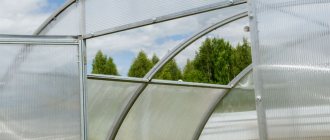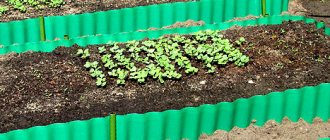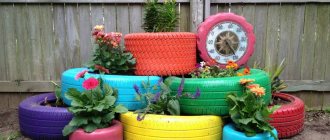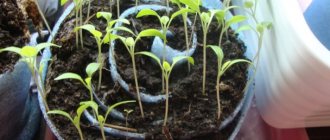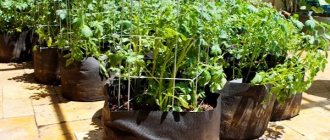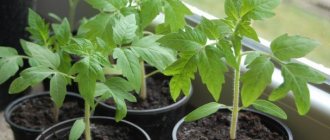Any experienced summer resident can confirm that in nature there are no materials from which it is impossible to assemble a simple greenhouse or greenhouse. For example, the well-known packaging stretch film, its name is often distorted in pronunciation, is called stretch material, perhaps due to associations with wardrobe items. So, a greenhouse made from stretch film can be built with your own hands for almost pennies, and it takes a little more than a couple of weekends.
A greenhouse made from stretch film is somewhat inferior in design to polycarbonate buildings
Design Features
Almost everyone has had to deal with stretch packaging film. Without even thinking about it, we can name three main characteristics of stretch packaging:
- High transparency, the material transmits sunlight much better than polyethylene, so covering greenhouses with stretch film doesn’t look so crazy;
- Famous elasticity and “stickiness” of the film. A properly wound stretch film package will never slip or tear, except, of course, in force majeure circumstances;
- The strength of the material is quite good; tearing thin plastic is not difficult, but for packaging in several layers, the tensile strength exceeds even the strength of polyethylene. Stretch film packaging can become stretched or tangled, but it can't be removed without a sharp knife.
This means that if you cover the greenhouse with stretch film, you don’t have to worry too much that due to strong gusts of wind, falling branches of neighboring trees, or other unpleasant phenomena, a hole will form in the greenhouse wall, and over time the entire film covering will be torn into rags.
A huge advantage is the low cost, this makes it possible to build a budget greenhouse from stretch film at minimal cost, you just need to choose the right project, and most importantly, follow the technology of laying the film on the supporting frame of the greenhouse or greenhouse.
Important! Stretch film has one undeniable advantage that no other polymer material has - several layers laid on top of each other stick together without any adhesive coating.
This means that stretch film cladding must be laid on almost any surface, naturally, subject to certain rules.
A greenhouse can be built from anything, the main thing is to properly wrap the stretch film
Pros and cons
Stretch film is not intended for covering plantings, unlike more expensive and less elastic greenhouse material. However, it has advantages:
- can last 2-3 seasons;
- does not deteriorate due to long-term storage;
- retains heat and moisture well;
- does not require additional fasteners.
In terms of thermal insulation, a finished greenhouse is practically no different from a permanent structure made of cellular polycarbonate, but costs less and is lightweight. Several layers of material, between which air, retain the temperature, reduce the negative impact of direct sunlight. The primary film is permeable to the UV spectrum, so the plants receive all the necessary substances and ripen noticeably faster.
On a note! The use of a secondary type is not recommended. There may be oil droplets on its surface, and the transparency is at least 40 percent lower.
When building a greenhouse, you can almost completely avoid complex fasteners. The elasticity of the material allows you to create complex shapes, while reducing the load on the main frame. The speed of construction is noticeably increasing.
Inside such a greenhouse, the air will instantly warm up, but in hot and sunny weather this can be dangerous for the plants. If you do not provide special flaps for ventilation, the structure can only be used for a few months a year. It is extremely difficult to make moving elements from such a material, which is also called one of the disadvantages of stretch. Such a greenhouse quickly loses its original appearance: the generated electricity literally attracts dust, so it is necessary to regularly wash the surface to ensure access to the sun to the plants. Because of the structure, this is not easy to do.
Read also:
DIY glass greenhouse
Glass greenhouses are one of the most durable options. It is structurally more complex than a simple geofabric greenhouse...
Options and schemes for greenhouses made of stretch film
Despite the certain democratic nature of the material, stretch film requires compliance with certain rules for laying the cladding. In theory, it is possible to cover a greenhouse with stretch film if the frame is rounded or dome-shaped, if it occurs to someone to build a similar type of greenhouse.
But to keep the cladding on the rounded surface, you will have to make incredible efforts.
Therefore, in order to avoid unnecessary problems, it is recommended to build a greenhouse with your own hands from stretch film of a more traditional design, for example, a rectangular or square type. Moreover, the dimensions of the stretch film strip were planned and selected specifically for packaging in the form of boxes.
In the simplest case, a small greenhouse can be built on a flat roof in just a few hours of work.
You don’t have to worry about strength, the stretch film tightens and firmly holds the frame of the building
Essentially, these are several stakes or racks of timber driven into the ground at the corners of the greenhouse. Instead of a roof and floor, latticework made of wooden slats is laid. You can build such a greenhouse from stretch film in one visit to the dacha, and after the end of the season, the structure can be very easily disassembled and stored in a shed.
A flat roof is a problem for all small-sized greenhouse designs, so it makes sense to try to build a real greenhouse from stretch film, but with a gable roof.
Sometimes greenhouse owners do not even redo the structure, but simply add a gable frame assembled from a lightweight aluminum profile.
Tent and tent schemes for arranging the frame of a greenhouse are considered very popular; for example, it will not be difficult to build a greenhouse from stretch film with your own hands, photo.
Formally, the size and shape of a greenhouse for stretch film are not limited in any way; if you have the time, money and desire to experiment, then it is quite possible to build even such a dome-shaped structure as in the photo below.
There is no economic or any design advantage in using complex dome or arched structures; stretch film is unlikely to be able to compete with polyethylene or PVC coatings. Its scope of application is inexpensive structures assembled in a few hours literally “on the knee”. And even if you manage to build a full-size complex greenhouse with your own hands from stretch film, you will still have the problem of restoring and repairing the film cladding. You will have to regularly add and wrap the torn areas with new patches and layers of stretch film.
Usually two layers of stretch film are laid; for winter greenhouse models the thickness is doubled
Therefore, the stretch option is inexpensive, compact and fast, in fact, this is what all the fuss is about, since building a greenhouse with your own hands from stretch film literally costs pennies, video:
How to build and wrap a greenhouse with stretch film
The construction of a greenhouse begins with calculations. Dimensions are determined taking into account the number and type of crops grown. For example, for bush plants, you can make a greenhouse from stretch film with a height of one and a half times the maximum growth of the crop. A height of 80 cm is sufficient for cucumbers. However, low greenhouses are difficult to maintain. The normal height is 1.5-1.7 m.
The length is taken arbitrarily, and the width is calculated taking into account the number of beds. Usually it is done alone. The greenhouse is given a width of 1 m. If there are two beds, then the width of the building is doubled, in addition, 30 cm is added to the path. It is easier to build two narrow greenhouses standing next to each other, designed for one bed. A path is left between the structures to clear the snow and wash the stretch film shelter.
The calculation of the frame begins with determining the number of arcuate supports. The indicator depends on the length of the structure. If the supports are strong and low, the wind load on the greenhouse is weak, they are placed at a distance of 2.5 m. With an increase in the wind load and dimensions of the structure, the pitch of the supports is reduced to 1.5 m. If there is no foundation, each support is buried at least 50 cm into the ground.
The consumption of stretch film depends on its quality and the dimensions of the frame. PVC fabric is usually stretched in two layers. The edges overlap 1/3 of the width of the strip. To calculate the required amount of canvas, measure the perimeter of the greenhouse frame. 1/3 is added to the indicator and multiplied by 2. The finished result is increased by another 10%. The reserve is needed for the formation of a “skirt” near the ground. The hanging edge will protect from the wind. It is important to remember that stretch film stretches. To avoid a large remainder, the resulting calculation result is divided by 2.
In the video, a greenhouse for pennies made of stretch film:
The assembly of the structure begins with the installation of the frame. Light arcs made of plastic pipes are simply buried in compacted soil or put on driven-in reinforcement pins. If a wooden base is required, it is assembled in the form of a rectangular frame made of timber. The joints are reinforced with mounting corners. Arc-shaped supports are attached to the side of the frame with clamps and self-tapping screws.
The assembly of a wooden or metal frame is carried out in a different sequence. The end sides of the greenhouse are created first. The second stage involves assembling the lower trim, installing supports, and finishing with the top trim.
The final step is to cover the greenhouse with stretch film, and work begins from the top. The first to lay a horizontal turn under the supports to fix the canvas. The first layer of film does not overlap. The lanes overlap when moving backwards from top to bottom.
The door and vents for ventilation are difficult to manufacture. In the selected area, the stretch film is stapled to the frame, if it is wooden. The sheet is secured to plastic pipes with clamps. Door and window leaves are made from glazing beads. The film is stapled to the frame in the area attached to the frame of the greenhouse. The edge of a knife is used to cut openings.
Material calculations
In order to estimate the level of future costs, we will try to make an approximate calculation of the amount of materials for the construction of a standard version of a greenhouse made of stretch film.
First of all, for the frame structure you will need:
- For the manufacture of walls there are four corner beams 60x60x2500 mm, the same amount for piping along the lower and upper levels;
- For diagonal struts on the walls, you will need six pieces of 40x40x3000 mm slats;
- To make a hatch and a window, five pieces of timber 50x50x2000 mm, you can also make an entrance door from it;
- For the roof truss system, four triangles are made; in total, 16 slats of 40x40 mm, 300 cm long, are required.
The amount of stretch film must be calculated based on the total surface area of the greenhouse, taking into account the roof slopes. In theory, the stretch coating should be laid with an overlap of at least 10% of the width of the film; in practice, stretch film is simply purchased with a reserve.
Standard tape for manual wrapping and packaging of goods has a width of 450-500 mm; one such roll contains 300 m of material or 120-150 m2. If you are making a regular greenhouse, one roll is enough, but if you plan to use a greenhouse made of stretch film in winter, then the number of layers will need to be increased at least three times, which means it is enough to purchase two reels.
LiveInternetLiveInternet
https://delaysam.ru/sadovodstvo/sadovodstvo60.html
As you know, tomatoes and cucumbers cannot be grown in the same greenhouse or greenhouse. Tomatoes need high temperatures with low humidity (aka, “hello, late blight”), i.e. dry climate. But cucumbers do not tolerate very high temperatures and high humidity (at high temperatures, cucumbers sharply reduce their fruit set). In general, a farm needs at least 2 greenhouses or greenhouses.
However, given the fact that cucumbers are a fairly early-ripening crop (the harvest begins to arrive in 50-60 days), it is too expensive to build a special greenhouse for cucumbers. A real greenhouse is not a cheap pleasure. Therefore, you can easily get by with an ordinary film greenhouse.
Using various “recycled” materials on my farm, I noticed the fact that stretch packaging film is much more stable than regular polyethylene film sold for greenhouses. Having lain for 3 years under the sun, rain and snow, the stretch film has practically not lost its strength properties. While ordinary film, even after one summer under the sun, breaks even from a slight load, and after two, it crumbles even from a simple touch.
Another argument in favor of using stretch film for a greenhouse was the economic factor. A roll of several kilograms of packaging film (this is 300-400 or more meters) costs about 200-300 rubles. With a width of 50 cm, this is several hundred square meters. And even taking into account the fact that the film will have to be used in a multilayer version, the coating is 2-3 times cheaper than using regular greenhouse film!
And finally, multilayer covering of a greenhouse with stretch film forms a much warmer coating (since air gaps are formed between the layers) and resembles cellular polycarbonate in structure.
The design of a greenhouse made from stretch film has the peculiarity that the film is quite thin and narrow (compared to conventional greenhouse film). Stretch film “stretches” and sticks together well. If regular film needs to be cut and attached to the frame in pieces, then with stretch film you just need to wrap the entire greenhouse in several layers. Looking ahead a little, I will say that the “wrapping” process is much simpler than attaching conventional film.
When growing cucumbers in open ground, it is best to use short-climbing or bush varieties. But when growing cucumbers in a greenhouse, it is more profitable to use long-climbing varieties of cucumbers, since they give a greater yield from the area of fertile soil (and there is not much of it in the greenhouse). In this case, the lashes are placed vertically, they are better illuminated, and a larger number of plants can be placed in a smaller area. Those. the greenhouse should be more “vertically oriented”.
I already had the frame of a cucumber greenhouse (which had to be covered with new plastic film every year). This time I decided to use stretch packaging film. After laying the frame on its side, I started with the roof. The edge of the film is fixed and we begin to wrap the roof plane. You can make it single-layer, or you can make it two-layer (for better thermal insulation). We start from the part of the roof that will be lower, so that each subsequent layer of film overlaps the previous layer (with an overlap of about 5-10 cm) and water does not get inside the greenhouse. The roof should be made thicker, in 5-8 layers, since in winter there will be snow on it.
Then we proceed to wrapping the greenhouse itself, also starting from the very bottom. Having made approximately 3-4 turns without overlap, we begin to gradually raise the film by 10 cm for each turn. In this way, a very durable and warm greenhouse covering with a thickness of 5 layers of stretch film is formed. In terms of strength, it is many times superior to conventional greenhouse film, and in terms of durability - time will tell. I'm at least counting on 2-3 seasons, although during one it is much more profitable than regular film. The film is not attached to the frame in any way, since the wrapping is tight, and the film itself is perfectly fixed to the frame, and even gives it significant rigidity, compressing it.
After the entire greenhouse is wrapped with film, you have to make an entrance door to the greenhouse (and then a ventilation window). To install the door in the selected location, we use a stapler to “shoot” the film onto the frame with staples and then press the film to the frame with strips on the screws. And then we cut through the doorway with a utility knife. Generally speaking, you can insert the door in advance, and then simply cut a gap so that the door can open. Of course, in this case it will be necessary to press the film with the strips to the door.
Since the frame has a fairly large windage, it is necessary to take measures to ensure its stability. You will need to either attach the jibs to its side walls, or provide it with some kind of anchor elements, or assemble the frame on a very stable base.
As the initial practice of operation showed, the greenhouse turned out to be very effective. Even on a cloudy day, the difference in temperature “outside - inside” is usually 8-10 degrees. And as soon as the sun comes out, the temperature inside quickly rises to 30-35 degrees. This temperature cannot be called comfortable for any plants, so it is necessary to add an automatic ventilation system and protection against overheating to the greenhouse. But this is a topic for another article...
Greenhouse made of stretch film on the forum. Comments and additions.
Konstantin Timoshenko
Which stretch film to choose for a greenhouse
You can often come across the opinion that for the manufacture of small greenhouse greenhouse buildings, the type and brand of stretch material is not particularly important. In fact, both PVC and polypropylene material will work for most small greenhouses.
Important! Film for food packaging, even in theory, cannot be considered as a covering for greenhouses. The first heavy rain will destroy the greenhouse; even reinforcement with adhesive tape will not save it.
If you plan to build a full-fledged greenhouse 3x4 meters, then it is best to choose EVA stretch film with a thickness of at least 20 microns. There are brands with a thickness of 30 microns; working with such stretch coatings is quite difficult, since you have to lay the film by hand, and this requires significant physical effort.
You must definitely pay attention to the thickness, since most stretch films sold have a characteristic of 17-20 microns.
How to make a greenhouse from stretch film
The process of manufacturing a small greenhouse building can be formally divided into two very important stages:
- Arrangement of the frame itself from wooden slats, slabs, lumber;
- Windings of the structure with stretch film.
The connection of the frame parts is carried out using ordinary self-tapping screws; at first glance, it looks very unreliable, but this is not entirely true. After the stretch film is wound, the frame of the greenhouse will turn into a dense and durable house, just as a pallet with stacked boxes after wrapping with stretch does not fall apart even after being transported along domestic roads.
Selecting a location and making a foundation
For the construction of a greenhouse complex, a site with the most dense soil is selected. If the soil is too loose due to sand, then the surface is additionally covered with a mixture of gravel and clay, all of which is carefully compacted to the state of a dirt track. It is impossible to leave the site with loose soil; the very first rain will turn the greenhouse into a real swamp.
The frame is made on steel supports from the corner
The place on the plot is chosen arbitrarily; the dimensions of the greenhouse are 2x2 m, so there is always a well-lit spot in the beds for it. Since the lining of the greenhouse is made of soft packaging material, it is still better to place the building away from the trees.
We install wooden pegs on the softened area and pull the marking cord. According to the diagram, the box is made of 40x40 wooden beams, the weight of the frame is small, so the greenhouse can be placed on metal stakes made from a corner.
We drive the corners into the ground and drill holes in them so that the vertical posts can be secured.
Greenhouse assembly
The next step is to horizontally tie the finished foundation with wooden slats or beams. It is clear that before assembling the structure, you will need to level each element using a building level.
Next, we attach the vertical corner posts; they also need to be tied with horizontally laid timber. All elements of the greenhouse are connected using ordinary self-tapping screws and a screwdriver.
Everything is assembled with self-tapping screws
We assemble the roof of the greenhouse from two triangles, lifted onto the walls, and attach it to the frame, connecting the tops with a ridge.
Important! The roof slopes can also be made from stretch film, but since this is the most vulnerable part of the greenhouse, it is best to lay cellular polycarbonate on the surface or sew a sheathing of 20x20 mm planks.
How to wrap a greenhouse with stretch film
The frame is covered with stretch tape with maximum tension on the film, so the material is not cut into strips, as is usually the case when working with polyethylene fabric, but is laid in one continuous stream, unwinding the roll. To make it more convenient to work, thread a pipe inside the stretch film reel and, holding it with your hands, wrap it around the frame of the greenhouse.
The winding starts from the bottom, sequentially moving to the parts located above
The next step is to fix the wound stretch film with wooden planks and self-tapping screws at the location where the future door will be installed. After this you can cut out the doorway. Since this part of the greenhouse frame turns out to be the most loaded, the entire facade is often cut out.
Option for making a greenhouse roof from stretch film
To strengthen the door frame, it is wrapped with stretch film at the same time as the walls in a figure eight pattern. The door itself is made from waste or remnants of timber; after the dimensions of the door leaf are brought into line with the frame, it is wrapped with at least six to seven layers of stretch tape.
Making a greenhouse
Long-climbing cucumber varieties are better suited for growing in a greenhouse (see Cucumber varieties for greenhouses). This variety will give a larger harvest. At the beginning of the greenhouse construction, you can calculate a business plan for construction. (see Business plan for a greenhouse) With this choice, it is better to place the vines vertically, there will be better lighting and you can place a larger number of plants. This means that it is worth making a vertically oriented greenhouse.
Preparation
If you have a ready-made greenhouse, then we will tell you how to treat it with stretch film. Those who don't have one will have to do this work.
- We determine the place. It is better to choose the sunny side of the site;
- We mark all dimensions on the ground and dig a pit, with a depth of 60-70 cm;
- Next we make a box. The material can be slate or wood;
- We install the frame. It can be made of metal rods or wood. We concrete the metal into the soil. The bottom of the tree must be reinforced with timber. We should have a rigid structure;
- Place a layer of thermal insulation on the soil. You can use sand, gravel or crushed stone;
- We apply a layer of organic litter, it will heat the greenhouse, you can use humus, leaves or straw;
- We lay a layer of biofuel. Here you can go the traditional route and use manure. Before planting cucumbers, the soil should be watered with warm water. The beginning of rotting will heat the greenhouse. Watering should be done a week before planting.
Attention. The stretch film is not cut out, but is used to wrap the greenhouse. For this design, a rectangular greenhouse is better suited. In an arched structure it will be difficult to secure the material on top. It is held in place by tension
Apply stretch film
After completing the preparatory work, you can begin installing the film. To make a stretch greenhouse, the structure should be wrapped in film. First we make a greenhouse; stretch film is applied after installing the frame.
- A greenhouse made from this film should begin to be covered with the material from the roof. We start laying from the bottom and work our way to the top. The layers are applied overlapping. This will eliminate the possibility of moisture getting under the film. The roof should be covered in several layers, about eight. It should be taken into account that in winter there will be snow on it, and this is an additional load. The film overlap is about 10 cm.
- Having closed the roof, we proceed to wrapping the bottom of the structure. This is also done from the bottom. To begin with, we wind in 3-4 layers without overlap, then we raise each layer by about 10 cm with each turn. We will get a warm and fairly durable coating, which is several times stronger than conventional film.
- In this version, fastening to the frame is not done, the film fits under tension and does not require additional fasteners, it is well fixed on the frame due to its elastic properties;
- When we have wrapped the entire greenhouse, we should make a door and a window in it. We choose a place for these structural elements and use a stapler to staple the film to the frame of the greenhouse. If the greenhouse is made of metal, holes should be made for fastening with self-tapping screws;
- We take planks of wood and cut them to size. We fasten it using self-tapping screws to the body along the contour of the intended elements;
Attention: Fasten the strip firmly. The self-tapping screw should go into the base block at least two-thirds of its thickness. The film is under tension due to its elasticity and should be held not by a self-tapping screw, but by the plane of the strip. Therefore, before installation, it is better to pass it through a thickness planer, this will ensure a tight fit of the entire plane.
- We make a cut in the film in place of the door. It was possible to make the door at once and wind it together with the frame, only in this case the strips should be used to press the film immediately so that the film tension is proper;
- We install the window in the same order. If the greenhouse is large, then it will be difficult to maintain the temperature with one hole; in this case, two windows should be made, which should be located at both ends of the greenhouse;
- If the stretch film and greenhouse have a large windage area, take the necessary measures to ensure the stability of the structure. The jibs should be attached to the walls of the structure. Or secure it using anchors.
Practice shows that in a greenhouse of this type, even in cloudy weather, the difference in temperature inside and outside the room is about 10 degrees. And as soon as the sun appears, the temperature rises quite quickly to 35 degrees. This is quite a high temperature and the greenhouse will need good ventilation.
How to make a greenhouse from stretch film with your own hands
The production of full-size greenhouse structures is usually required for growing flowers and vegetables throughout the summer, sometimes there is simply no special need for this; it is easier and more affordable to make a small greenhouse in the form of a box or tent.
Option for making a greenhouse roof from stretch film
For example, to grow seedlings in small quantities, a greenhouse can be made in the form of a wire frame or a thin wooden slat. The structure is wrapped with 4-5 layers of stretch film, both horizontally and vertically. All that remains is to carefully cut out the removable roof of the greenhouse, and the finished box can be installed on the beds.
Greenhouse operating standards
When using a wooden frame, it must be treated annually with a special agent to prevent rotting. The service life of a wooden structure is 5–7 years. A frame made of profile pipes is suitable for use for 10 years or more. The plastic pipes used in the frame will allow the greenhouse to operate for about 50 years. Before frost, the film does not need to be removed. If it is properly tensioned, it can last 2-3 years.
Did you know? The largest greenhouse structure in the world has an area of 22 thousand m².
It is located in Cornwall (UK) and contains about 1 million plants that can be found in wildlife around the globe. So, a greenhouse made of stretch film is an affordable, cheap and at the same time effective option . It’s easy to do it yourself, having only improvised means and simple tools at hand. Covering made from stretch film is 2-3 times cheaper than covering from special greenhouse film, and with proper installation it lasts 2-3 seasons.
Pros and cons of stretch film greenhouses
If we compare stretch tape with polyethylene or polyester film, it becomes clear that stretch has unique properties:
- Resistance to temperature changes;
- Stretch film easily withstands punctures and even small cuts, while any other option for cladding a greenhouse in such conditions easily turns into rags;
- High elasticity, good adaptation and adhesion to any surface;
- High transparency of the material; if you do not wind many layers, then a greenhouse made of stretch film will transmit enough heat and light.
It is clear that stretch film also has disadvantages. If the frame of the greenhouse was wrapped incorrectly, with errors or with insufficient tension, then it will not be possible to re-lay the old film; at a minimum, you will need to remove the old material, clean the frame, and only after that will it be possible to lay several layers of new stretch film.
In addition, a roof made of stretch film without sheathing is practically doomed to deformation and compression; for example, in winter, a thick layer of snow can easily push the roof slope into the room. As a result, every wintering of the greenhouse entails the risk of being damaged.
Common mistakes and recommendations
When making greenhouses and greenhouse buildings lined with stretch film, the main mistake is trying to save on material. Many summer residents believe that with a large number of layers, the roof and walls may not allow sunlight to pass through. Actually this is not true. Even with a five-layer wrapping, the roof transmits enough heat and light, and in addition, the thicker the stretch film cladding, the better the thermal insulation.
The second common mistake is due to the fact that many DIYers try to build greenhouses and greenhouses from individual parts wrapped in stretch film. Typically, this approach results in a weak structure that quickly falls apart. In addition to individual winding, the greenhouse must be wrapped like a cocoon, so that all the parts and elements are combined into one whole.

